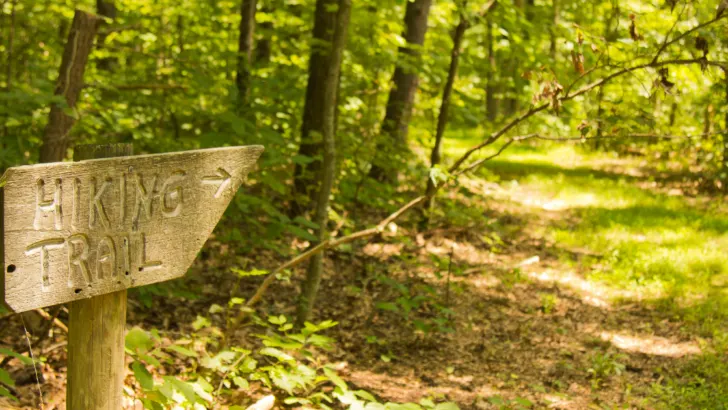Hiking is a popular physical activity that not only allows you to explore nature but also provides numerous health benefits. If you’re wondering whether hiking will get you in shape, the answer is yes. Hiking is a great way to improve your cardiovascular health, build strength and endurance, and burn calories.
The benefits of hiking for fitness are numerous. It can help lower your risk of heart disease, stroke, and high blood pressure. Hiking can also help improve your balance, flexibility, and coordination. Additionally, hiking is a low-impact activity that is easy on your joints, making it an excellent choice for people who are overweight or obese and want to start exercising.

Key Takeaways
- Hiking is an effective way to improve your cardiovascular health, build strength and endurance, and burn calories.
- Hiking can help lower your risk of heart disease, stroke, and high blood pressure, and improve your balance, flexibility, and coordination.
- Hiking is a low-impact activity that is easy on your joints, making it an excellent choice for people who are overweight or obese and want to start exercising.
Will Hiking Get Me in Shape?
As someone who has been hiking for years, I can confidently say that hiking is an excellent way to get in shape. Hiking is a low-impact exercise that can help you burn calories, build endurance, and strengthen your muscles.
Hiking can easily burn over 500 calories per hour, making it an effective way to lose weight and improve your overall fitness. Additionally, hiking works out your lower body and core muscles, helping you build strength and endurance.

However, it’s important to note that the intensity of your hike will determine how much of a workout you get. A leisurely stroll through the park won’t be as effective as a challenging hike up a mountain. So, if you’re looking to get in shape through hiking, make sure to choose trails that are challenging enough to give you a good workout.
It’s also important to note that hiking is not a substitute for a well-rounded fitness routine. While hiking can help you get in shape, it’s important to incorporate other forms of exercise, such as strength training and cardio, into your routine to get the most benefits.
Related Posts:
The Benefits of Hiking for Fitness
Hiking is an excellent way to get in shape and improve overall fitness. Not only does it provide cardiovascular benefits, but it also helps to increase muscle strength and endurance, promote weight loss, reduce stress, and improve mood.
Increased Cardiovascular Health
Hiking is a great way to get your heart pumping and improve your cardiovascular health. It helps to increase blood flow and oxygen delivery to your muscles, which can improve endurance and overall fitness. Hiking at a moderate intensity can also help to lower blood pressure and reduce the risk of heart disease.

Increased Muscle Strength and Endurance
Hiking is a full-body workout that can help to strengthen and tone your muscles. It works your legs, glutes, core, and upper body, helping to improve overall strength and endurance. Hiking on uneven terrain also helps to improve balance and stability.
Weight Loss
Hiking is a great way to burn calories and promote weight loss. It can burn up to 500 calories per hour, depending on the intensity and duration of the hike. Hiking also helps to build lean muscle mass, which can increase your metabolism and help you burn more calories throughout the day.
Reduced Stress
Hiking is a great way to reduce stress and improve mental health. It provides an opportunity to disconnect from technology and connect with nature, which can help to reduce stress and improve mood. Hiking also helps to release endorphins, which are natural mood boosters.

Improved Mood
Hiking can also help to improve mood and overall mental health. It provides an opportunity to get outside and enjoy nature, which can help to reduce anxiety and depression. Hiking also helps to increase confidence and self-esteem, which can improve overall mood and well-being.
Related Posts:
How Hiking Can Get You in Shape
Hiking is a great way to get in shape and improve your overall health. Here are a few ways that hiking can help you get in shape:
Start with a Moderate-Intensity Hike
If you’re new to hiking or haven’t been active in a while, start with a moderate-intensity hike. A moderate-intensity hike is one that gets your heart rate up and makes you breathe harder, but still allows you to carry on a conversation without too much difficulty. A good rule of thumb is to aim for a hike that takes about 30 minutes to an hour to complete.
Increase the Intensity of Your Hikes over Time
Once you’ve built up some endurance, gradually increase the intensity of your hikes. This can be done by hiking on steeper terrain, hiking for longer periods of time, or carrying a heavier backpack. As your fitness level improves, you’ll be able to tackle more challenging hikes.

Vary Your Hiking Routes
To keep things interesting and challenge different muscles, vary your hiking routes. Try hiking on different terrains, such as hills, mountains, or trails with uneven surfaces. You can also try hiking at different times of the day or in different weather conditions.
Add Weight to Your Hikes
Adding weight to your hikes is a great way to increase the intensity of your workout. You can do this by carrying a backpack with some weight in it. Start with a lightweight, such as a few pounds, and gradually increase the weight over time.
Remember to always stay hydrated and wear appropriate clothing and footwear when hiking. With consistency and dedication, hiking can be a fun and effective way to get in shape.
Related Posts:
Studies That Have Looked at the Effects of Hiking on Fitness
Based on my research, hiking can be an effective way to improve fitness. Several studies have found that hiking can increase cardiovascular endurance, muscular strength, and overall physical fitness.
In one study, researchers compared the effects of hiking and treadmill walking on cardiovascular fitness. They found that both activities improved cardiovascular fitness, but hiking produced greater improvements in muscular endurance and overall physical fitness.

Another study found that hiking on uneven terrain can improve balance and stability, which are important for preventing falls and injuries. Hiking on hills and inclines can also increase leg strength and endurance.
In addition to physical fitness benefits, hiking can also have mental health benefits. Spending time in nature and green spaces has been shown to reduce stress and improve mood. Hiking can also provide a sense of accomplishment and satisfaction, which can boost self-esteem and confidence.
Overall, the research suggests that hiking can be a great way to improve fitness and overall health. However, it’s important to start slowly and gradually increase the intensity and duration of hikes to avoid injury. It’s also important to wear appropriate footwear and clothing, stay hydrated, and be prepared for changes in weather and terrain.
Tips for People Who are Overweight or Obese and Want to Start Hiking
If you’re overweight or obese and want to start hiking, congratulations! Hiking is a great way to get in shape and enjoy nature. Here are some tips to help you get started:
Start with Short, Easy Hikes
Don’t try to tackle a difficult trail on your first hike. Start with short, easy hikes on flat terrain. Gradually increase the length and difficulty of your hikes as you get in better shape.

Talk to Your Doctor
Before starting any exercise program, it’s a good idea to talk to your doctor. Your doctor can help you determine if hiking is safe for you and give you advice on how to get started.
Wear Comfortable Shoes and Clothing
Wear comfortable shoes and clothing that are appropriate for the weather. Choose shoes with good support and traction to prevent slips and falls. Dress in layers so you can adjust your clothing as needed.

Bring Plenty of Water and Snacks
Bring plenty of water and snacks to keep you hydrated and energized during your hike. Choose healthy snacks like fruit, nuts, and granola bars.
Listen to Your Body
Pay attention to your body during your hike. If you feel tired or in pain, take a break or turn back. Don’t push yourself too hard too soon. Remember, hiking is supposed to be enjoyable, not painful.

By following these tips, you can start hiking safely and enjoyably. Remember to start slow and gradually increase the difficulty of your hikes. With time and effort, you’ll be able to tackle more challenging trails and get in great shape.
Information About the Different Types of Hiking Trails and How to Choose the Right One for Your Fitness Level
When it comes to hiking, there are different types of trails to choose from. Each type of trail is classified based on its difficulty level, length, and terrain. It is essential to choose the right trail that matches your fitness level to avoid overexertion or injury. Here are the three main types of hiking trails and how to choose the right one for your fitness level.
Easy Trails
Easy trails are perfect for beginners or those who want to enjoy a leisurely hike. These trails are usually flat, well-maintained, and have a short distance. They are ideal for families with children, seniors, or people with mobility issues. Easy trails are also great for those who want to enjoy nature without pushing themselves too hard.

When choosing an easy trail, consider the distance, terrain, and weather conditions. You can check the trail difficulty rating before starting your hike. Always bring enough water, wear comfortable shoes, and dress appropriately for the weather.
Moderate Trails
Moderate trails are for hikers who want a bit of a challenge. These trails are longer and have some elevation gain, but they are still manageable for most people. Moderate trails offer stunning views and a chance to explore nature while getting a good workout.

Before choosing a moderate trail, assess your fitness level and hiking experience. Consider the trail length, elevation gain, and terrain. It is crucial to bring enough water, snacks, and appropriate gear. Always inform someone of your hiking plans and expected return time.
Difficult Trails
Difficult trails are for experienced hikers who want a strenuous workout and a challenge. These trails are longer, steeper, and have rugged terrain. Difficult trails require good physical fitness, hiking experience, and proper gear. They offer breathtaking views, a sense of accomplishment, and an adrenaline rush.

When choosing a difficult trail, assess your fitness level, hiking experience, and the difficulty rating of the trail. Always bring enough water, snacks, and appropriate gear. Inform someone of your hiking plans and expected return time. Consider hiking with a partner or a group for safety.
Related Posts:
Conclusion
In conclusion, hiking is an excellent way to get in shape and maintain fitness levels. It is a low-impact exercise that can be done at any age and fitness level. Hiking provides a full-body workout that targets different muscle groups and helps to improve cardiovascular health.
To get in shape for hiking, it is important to build strength, stamina, and flexibility. You can achieve this by incorporating regular exercise into your routine, such as strength training, cardio, and stretching. A healthy diet is also crucial to support your body’s needs and fuel your hikes.

When hiking, it is important to start slowly and gradually increase the intensity and duration of your hikes. This will help to prevent injuries and allow your body to adapt to the demands of hiking. Always listen to your body and take breaks when needed.
In summary, hiking is an enjoyable and effective way to get in shape and maintain fitness levels. By incorporating regular exercise and a healthy diet into your routine, you can prepare your body for the challenges of hiking and enjoy the many benefits it has to offer.
Frequently Asked Questions
Is hiking a good way to improve fitness?
Yes, hiking is an excellent way to improve fitness. It is a low-impact exercise that can be done at any pace and for any length of time. Hiking can help improve cardiovascular health, build endurance, and strengthen muscles in the legs, core, and upper body.
What are the physical benefits of hiking?
Hiking offers numerous physical benefits, including improved cardiovascular health, increased endurance, strengthened muscles, and improved balance and coordination. Hiking can also help reduce the risk of chronic diseases such as heart disease, diabetes, and obesity.
How does hiking compare to other forms of exercise?
Hiking offers many of the same benefits as other forms of exercise, such as running, cycling, and swimming. However, hiking is a low-impact exercise that is easier on the joints than high-impact exercises like running. Hiking also provides the added benefits of being outdoors and connecting with nature.
Can hiking help with weight loss?
Yes, hiking can be an effective way to lose weight. Hiking burns calories and can help create a calorie deficit, which is necessary for weight loss. The amount of weight loss achieved through hiking will depend on factors such as the length and intensity of the hike, as well as the individual’s diet and lifestyle habits.
What are some tips for getting in shape through hiking?
To get in shape through hiking, it is important to start slowly and gradually increase the length and intensity of your hikes. It is also important to wear appropriate footwear and clothing, stay hydrated, and pack snacks and other essentials. Incorporating strength training exercises into your routine can also help improve your hiking fitness.
How frequently should one hike to see fitness improvements?
To see fitness improvements through hiking, it is recommended to hike at least two to three times per week. The length and intensity of the hikes should gradually increase over time to continue seeing improvements in fitness. It is also important to listen to your body and take rest days as needed to avoid injury or burnout.
